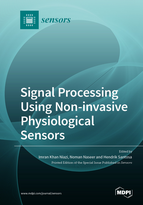Signal Processing Using Non-invasive Physiological Sensors
A special issue of Sensors (ISSN 1424-8220). This special issue belongs to the section "Intelligent Sensors".
Deadline for manuscript submissions: closed (31 December 2020) | Viewed by 53616
Special Issue Editors
Interests: neurorehabilitation; biomedical signal processing; machine learning; applied artificial intelligence; EEG; EMG
Special Issues, Collections and Topics in MDPI journals
Interests: neurorobotics; brain–computer interface; machine learning; artificial intelligence; feature extraction; classification; fNIRS; EMG; EEG
Special Issues, Collections and Topics in MDPI journals
Interests: functional near-infrared spectroscopy (fNIRS) data processing; statistical analysis for fNIRS signal; multi-modal neuroimaging; brain-computer interface (BCI) applications
Special Issues, Collections and Topics in MDPI journals
Special Issue Information
Dear Colleagues,
We would like to cordially invite you to participate in a Special Issue on “Signal Processing Using Non-Invasive Physiological Sensors”. This Special Issue shall concentrate on two aspects:
- Non-invasive biomedical sensors for the monitoring of physiological parameters from the human body. Today, a critical factor in providing a cost-effective healthcare system is improving the quality of life and mobility of patients, which can be achieved by developing non-invasive sensor systems, which can then be deployed in point of care, used at home or integrated into wearable devices for long-term data collection.
- Another factor which plays an integral part in a cost-effective healthcare system is the signal processing of the data recorded with non-invasive biomedical sensors. In this Special Issue, we aim to attract researchers who are interested in the application of signal processing methods to different biomedical signals such as an electroencephalogram (EEG), electromyogram (EMG), functional near-infrared Spectroscopy (fNIRS), electrocardiogram (ECG), galvanic skin response, pulse oximetry, photoplethysmogram (PPG), etc. We would encourage new signal processing methods or the use of existing signal processing methods for its novel application in the domain of physiological signals to help healthcare providers to make better decisions.
Original papers that describe new research on any of the themes mentioned above are welcomed. We look forward to your participation in this Special Issue.
Dr. Imran Khan Niazi
Dr. Noman Naseer
Dr. Hendrik Santosa
Guest Editors
Manuscript Submission Information
Manuscripts should be submitted online at www.mdpi.com by registering and logging in to this website. Once you are registered, click here to go to the submission form. Manuscripts can be submitted until the deadline. All submissions that pass pre-check are peer-reviewed. Accepted papers will be published continuously in the journal (as soon as accepted) and will be listed together on the special issue website. Research articles, review articles as well as short communications are invited. For planned papers, a title and short abstract (about 100 words) can be sent to the Editorial Office for announcement on this website.
Submitted manuscripts should not have been published previously, nor be under consideration for publication elsewhere (except conference proceedings papers). All manuscripts are thoroughly refereed through a single-blind peer-review process. A guide for authors and other relevant information for submission of manuscripts is available on the Instructions for Authors page. Sensors is an international peer-reviewed open access semimonthly journal published by MDPI.
Please visit the Instructions for Authors page before submitting a manuscript. The Article Processing Charge (APC) for publication in this open access journal is 2600 CHF (Swiss Francs). Submitted papers should be well formatted and use good English. Authors may use MDPI's English editing service prior to publication or during author revisions.
Keywords
- Biosensing
- Infrared detectors
- Portable technology
- Cutaneous temperature
- EEG
- EMG
- ECG
- fNIRS
- Applied signal processing
- Machine learning
- Artificial intelligence
- Real-world application
- Clinical environment
- Statistical analysis
- Multimodal neuroimaging
- Artifact detection and removal
- Noise removal
- Independent component analysis
- Signal filtering techniques









